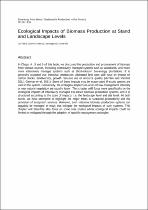JavaScript is disabled for your browser. Some features of this site may not work without it.
- ResearchSpace
- →
- Research Publications/Outputs
- →
- Book Chapters
- →
- View Item
| dc.contributor.author |
Du Toit, B

|
|
| dc.contributor.author |
Gush, Mark B

|
|
| dc.contributor.author |
Pryke, JS

|
|
| dc.contributor.author |
Samways, MJ

|
|
| dc.contributor.author |
Dovey, SB

|
|
| dc.date.accessioned | 2014-12-03T06:58:56Z | |
| dc.date.available | 2014-12-03T06:58:56Z | |
| dc.date.issued | 2014-09 | |
| dc.identifier.citation | Du Toit, B., Gush, M.B., Pryke, J.S., Samways, M.J. and Dovey, S.B. 2014. Ecological impacts of biomass production at stand and landscape levels. In: Bioenergy from Wood: Sustainable Production in the Tropics. Springer Publishing: New Delhi, India, pp 211-236 | en_US |
| dc.identifier.isbn | 78-94-007-7448-3 | |
| dc.identifier.uri | http://link.springer.com/chapter/10.1007%2F978-94-007-7448-3_10 | |
| dc.identifier.uri | http://hdl.handle.net/10204/7802 | |
| dc.description | Copyright: Springer publishing, New Delhi, India. Abstract attached. | en_US |
| dc.description.abstract | In Chapters 4, 5 and 6 of this book, the authors discussed the production and procurement of biomass from various sources, including extensively managed systems such as woodlands, and much more intensively managed systems such as short-rotation bio-energy plantations. It is generally accepted that intensive, production orientated land uses will have an impact on carbon stocks, biodiversity, growth resource use or resource quality (Achten and Verchot 2011; German et. al. 2011). Some of these impacts may be exacerbated if exotic species are used in the system. Conversely, the ecological impacts on areas of low management intensity or near natural vegetation are usually lower. This chapter will focus more specifically on the ecological impacts of intensively managed tree-based biomass production systems, and it is structured according to the scale of impacts, i.e. the landscape level and site level. At both levels, we have attempted to highlight the major treats to sustained productivity and the provision of ecosystem services. However, even intensive biomass production systems can arguably be managed in ways that mitigate the ecological impacts of such systems. This chapter will therefore also focus on some case studies where ecological impacts could be limited or mitigated through the adoption of specific management strategies. | en_US |
| dc.language.iso | en | en_US |
| dc.publisher | Springer | en_US |
| dc.relation.ispartofseries | Workflow;13672 | |
| dc.subject | Forest ecosystem management | en_US |
| dc.subject | Bio-energy plantation | en_US |
| dc.subject | Ecological management strategies | en_US |
| dc.subject | Biomass research | en_US |
| dc.title | Ecological impacts of biomass production at stand and landscape levels | en_US |
| dc.type | Book Chapter | en_US |
| dc.identifier.apacitation | Du Toit, B., Gush, M. B., Pryke, J., Samways, M., & Dovey, S. (2014). Ecological impacts of biomass production at stand and landscape levels., <i>Workflow;13672</i> Springer. http://hdl.handle.net/10204/7802 | en_ZA |
| dc.identifier.chicagocitation | Du Toit, B, Mark B Gush, JS Pryke, MJ Samways, and SB Dovey. "Ecological impacts of biomass production at stand and landscape levels" In <i>WORKFLOW;13672</i>, n.p.: Springer. 2014. http://hdl.handle.net/10204/7802. | en_ZA |
| dc.identifier.vancouvercitation | Du Toit B, Gush MB, Pryke J, Samways M, Dovey S. Ecological impacts of biomass production at stand and landscape levels.. Workflow;13672. [place unknown]: Springer; 2014. [cited yyyy month dd]. http://hdl.handle.net/10204/7802. | en_ZA |
| dc.identifier.ris | TY - Book Chapter AU - Du Toit, B AU - Gush, Mark B AU - Pryke, JS AU - Samways, MJ AU - Dovey, SB AB - In Chapters 4, 5 and 6 of this book, the authors discussed the production and procurement of biomass from various sources, including extensively managed systems such as woodlands, and much more intensively managed systems such as short-rotation bio-energy plantations. It is generally accepted that intensive, production orientated land uses will have an impact on carbon stocks, biodiversity, growth resource use or resource quality (Achten and Verchot 2011; German et. al. 2011). Some of these impacts may be exacerbated if exotic species are used in the system. Conversely, the ecological impacts on areas of low management intensity or near natural vegetation are usually lower. This chapter will focus more specifically on the ecological impacts of intensively managed tree-based biomass production systems, and it is structured according to the scale of impacts, i.e. the landscape level and site level. At both levels, we have attempted to highlight the major treats to sustained productivity and the provision of ecosystem services. However, even intensive biomass production systems can arguably be managed in ways that mitigate the ecological impacts of such systems. This chapter will therefore also focus on some case studies where ecological impacts could be limited or mitigated through the adoption of specific management strategies. DA - 2014-09 DB - ResearchSpace DP - CSIR KW - Forest ecosystem management KW - Bio-energy plantation KW - Ecological management strategies KW - Biomass research LK - https://researchspace.csir.co.za PY - 2014 SM - 78-94-007-7448-3 T1 - Ecological impacts of biomass production at stand and landscape levels TI - Ecological impacts of biomass production at stand and landscape levels UR - http://hdl.handle.net/10204/7802 ER - | en_ZA |






